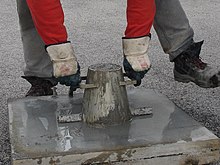Attempt to spread
The slump test is a method for determining the slump , a parameter for the consistency of fresh concrete . Thanks to the simple experimental setup, this concrete test can also be carried out directly on the construction site. Colloquially, the implementation of the experiment is simply referred to as a rattle because of the typical noise .
The spreading test cannot be used for foam concrete , single- grain concrete and with a maximum grain size of the aggregate of more than 63 mm. In addition, self-compacting concretes can not be tested with sufficient accuracy due to the limited size of the test table.
Application and structural engineering background
The spreading test plays a major role both on construction sites and in the concrete-producing mixing plants . The test is used to check the consistency of the fresh concrete in the factory before loading it onto a truck mixer and on the construction site immediately before installation. The test is particularly important if a mixture with a specified consistency or with a certain slump has been ordered due to the installation conditions (e.g. tight reinforcement layout ) or special requirements for the surface of the component (e.g. exposed concrete ).
If the fresh concrete is too viscous ( stiff ), cavities (larger pores , gravel pockets ) can occur during installation . Often, cavities only represent a visual defect, but if they accumulate they can also impair the load-bearing capacity of the component. In addition, exposed reinforcement is not protected from corrosion , so that renovation measures are often required.
attempt
Accessories and environmental conditions
- Standardized spreading table with a hinge on one side and with a handle and a stop to limit the lifting height on the opposite side. Dimensions: 70 cm × 70 cm
- Truncated cone-shaped container that is open at the top and bottom. (Height: 20 cm, diameter above: 13 cm, diameter below: 20 cm; 3.34 liters)
- Bucket with water, a small broom or something similar to moisten and clean the plate, a smoothing trowel or something similar, a small shovel
- horizontal, firm, non-resilient base
- if necessary, roofing in case of heavy rain
execution
First, the top of the table is moistened with water and the resulting film of water is removed with a smoothing trowel or the like. The surface should then be matt damp . This ensures that the consistency is not changed by the condition of the surface of the table. If the surface were dry, the slump would be less. A table that is too wet would distort the result in the other direction. Then place the truncated cone in the middle and fill it with fresh concrete using a small shovel. Excess concrete at the upper opening is smoothed off and the form is then pulled up. The concrete spreads out a little. Immediately thereafter, the movable side of the spreading table is lifted 15 times without jerking up to the stop (4 cm) and then dropped. There should be a minimum of 1 second to a maximum of 3 seconds between each pass (lifting and dropping). The fresh concrete spreads further through the vibrations. Finally, the diameter of the resulting “concrete cake” is measured crosswise twice. The mean diameter in millimeters is the slump . The determined dimension is rounded to 10 mm .
Evaluation and measures
| Consistency area | Slump class |
Slump in mm |
|---|---|---|
| very stiff | - | - |
| stiff | F1 | ≤ 340 |
| plastic | F2 | 350-410 |
| soft | F3 | 420-480 |
| very soft | F4 | 490-550 |
| flowable | F5 | 560-620 |
| very flowable | F6 | 630-700 |
| SVB | - | > 700 |
As described in the implementation, the result of the experiment is the diameter of the "concrete cake". The consistency or the consistency class of the fresh concrete can be easily determined on the basis of this value with the adjacent table.
If concrete was ordered with a certain consistency, the spread test on the construction site offers the possibility to check whether the target value is actually present. If this is not the case, the slump can be increased by adding superplasticizers . The experiment is then repeated. The inspection of individual batches allows the mixer foreman in the concrete plant to easily adapt the recipe and to adjust the system accordingly for upcoming batches.
Advantages and disadvantages
The great advantage of the experiment is that it is easy to set up and can be carried out quickly. Spreading tables are robustly built, easy to clean and do not require a power supply. As a result, the fresh concrete consistency can be checked on the construction site without much preparation.
The manual implementation of the experiment is to be regarded as disadvantageous . Since the standard allows a relatively large time window of 1 to 3 seconds between two runs, the tester is able to "rattle" a sample quickly or slowly and thus - intentionally or unintentionally - influence the slump. Because of this variability, DIN 1045-2 and DIN EN 206-1 stipulate a tolerance of ± 30 mm for compliance with the target value for consistency.
Norms and standards
- DIN 1048 - test method for concrete
- DIN EN 12350-5 - Testing of fresh concrete - Part 5: Slump
Web links
Individual evidence
- ^ Construction glossary: Slump - HeidelbergCement Germany website. Retrieved October 7, 2011.
- ↑ a b c d e f Zement-Merkblatt Betontechnik B4 - Fresh concrete: Properties and tests. (PDF) Association of German Cement Works eV, p. 3 f. , accessed June 16, 2013 .
- ↑ a b Lohmeyer et al .: Reinforced concrete construction: dimensioning - construction - execution . 8th edition. Vieweg + Teubner, Wiesbaden (2010). ISBN 978-3-8348-0866-0 . P. 38


